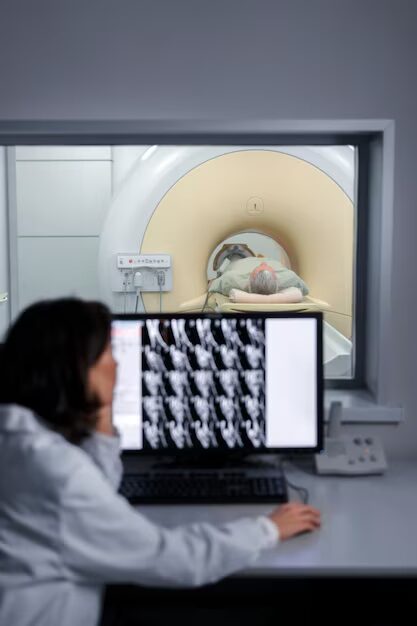Introduction
Genicular artery embolisation (GAE) is an innovative procedure in interventional radiology that has emerged as an effective treatment for managing chronic knee pain, particularly in cases of osteoarthritis. This minimally invasive technique targets the blood supply to inflamed areas within the knee joint, reducing pain and inflammation. This article explains how GAE works, its applications, and what patients can expect during the procedure.
What Is Genicular Artery Embolisation?
GAE is a minimally invasive procedure designed to reduce knee pain by limiting the blood flow to specific areas of the knee. The term “genicular” refers to the network of arteries that supply blood to the knee joint. By embolising—or blocking—these arteries, GAE reduces inflammation and alleviates pain caused by conditions such as osteoarthritis. GAE involves injecting small particles (emboli) such as tiny beads or coils into the geniculate arteries, which then block the blood flow to the targeted areas of the knee joint.
This reduced blood supply leads to a decrease in the size and activity of the inflamed tissues, ultimately providing pain relief and improving knee function.
The Role of Interventional Radiology
Interventional radiology (IR) plays a crucial role in the success of GAE. This medical specialty uses image-guided techniques to perform minimally invasive procedures. By employing advanced imaging modalities like fluoroscopy and CT scans, interventional radiologists can accurately locate the affected genicular arteries and perform embolisation with precision. This minimally invasive approach offers several advantages over traditional open surgery, including reduced risk of infection, faster recovery times, and less pain and scarring for patients.
Interventional radiologists are instrumental in selecting the most appropriate embolic agents and techniques for each individual patient, ensuring optimal treatment outcomes and minimising potential complications.
How Does Genicular Artery Embolisation Work?
Pre-Procedure Assessment
Before undergoing GAE, patients typically undergo a thorough evaluation. This may include:
- Clinical Assessment: Reviewing the patient’s medical history and symptoms.
- Imaging Tests: X-rays, MRI, or ultrasound scans to identify areas of inflammation and confirm suitability for the procedure.
Preparation for the Procedure
GAE is performed under local anaesthesia, which means the patient remains awake but experiences no pain. The interventional radiologist prepares the patient by sterilising the access site, usually located in the groin or wrist, where a small catheter will be inserted. Sedatives may be administered to help the patient relax during the procedure. The patient may be asked to lie still on an examination table during the procedure.
Catheter Placement and Imaging
Using fluoroscopic guidance, a small catheter is advanced through the blood vessels to the genicular arteries. Contrast dye is injected to highlight the arteries on the imaging system, allowing the radiologist to visualise the blood supply to the knee. This procedure is often performed to diagnose conditions such as peripheral artery disease (PAD) in the knee, which can restrict blood flow and cause pain or tissue damage. Catheter placement and imaging can also be used to guide minimally invasive interventions, such as angioplasty or stenting, to open blocked or narrowed arteries in the knee.
Embolisation
Once the target arteries are identified, embolic agents—such as microspheres or tiny particles—are delivered through the catheter. These agents block the blood flow to the inflamed areas of the knee, reducing inflammation and pain.
Post-Procedure Monitoring
After embolisation, the catheter is removed, and a small bandage is applied to the access site. Patients are typically monitored for a few hours before being discharged.
Benefits of Genicular Artery Embolisation
GAE offers several advantages, including:
- Minimally Invasive: No large incisions or surgical interventions are required.
- Quick Recovery: Most patients can resume normal activities within a few days.
- Pain Relief: Significant reduction in knee pain has been reported in many cases.
- Targeted Treatment: The procedure focuses specifically on the affected areas of the knee.
Applications of Genicular Artery Embolisation
GAE is primarily used for patients suffering from:
- Osteoarthritis: Particularly in cases where conventional treatments, such as medication or physical therapy, have been ineffective.
- Chronic Knee Pain: Caused by inflammation that does not respond to other treatments.
- Post-Surgical Pain: In rare cases, GAE may be used to manage pain following knee surgery.
Risks and Considerations
While GAE is generally safe, it is not without risks. Potential complications include:
- Bruising or Bleeding: At the catheter insertion site.
- Infection: Though rare, it can occur at the access site.
- Allergic Reaction: To the contrast dye used during the procedure.
Patients should discuss their medical history and any concerns with their interventional radiologist before proceeding.
Recovery and Outcomes
Most patients experience significant pain relief within a few weeks of the procedure. Recovery is typically quick, with minimal downtime. Regular follow-up appointments may be required to assess the long-term effectiveness of the treatment.
Conclusion
Genicular artery embolisation is a groundbreaking advancement in interventional radiology that provides an effective and minimally invasive solution for chronic knee pain. By targeting the blood supply to inflamed areas within the knee, GAE offers a safe and efficient alternative for patients who have not responded to traditional treatments. If you are considering this procedure, consult with an experienced interventional radiologist to determine if it is the right option for you.






























